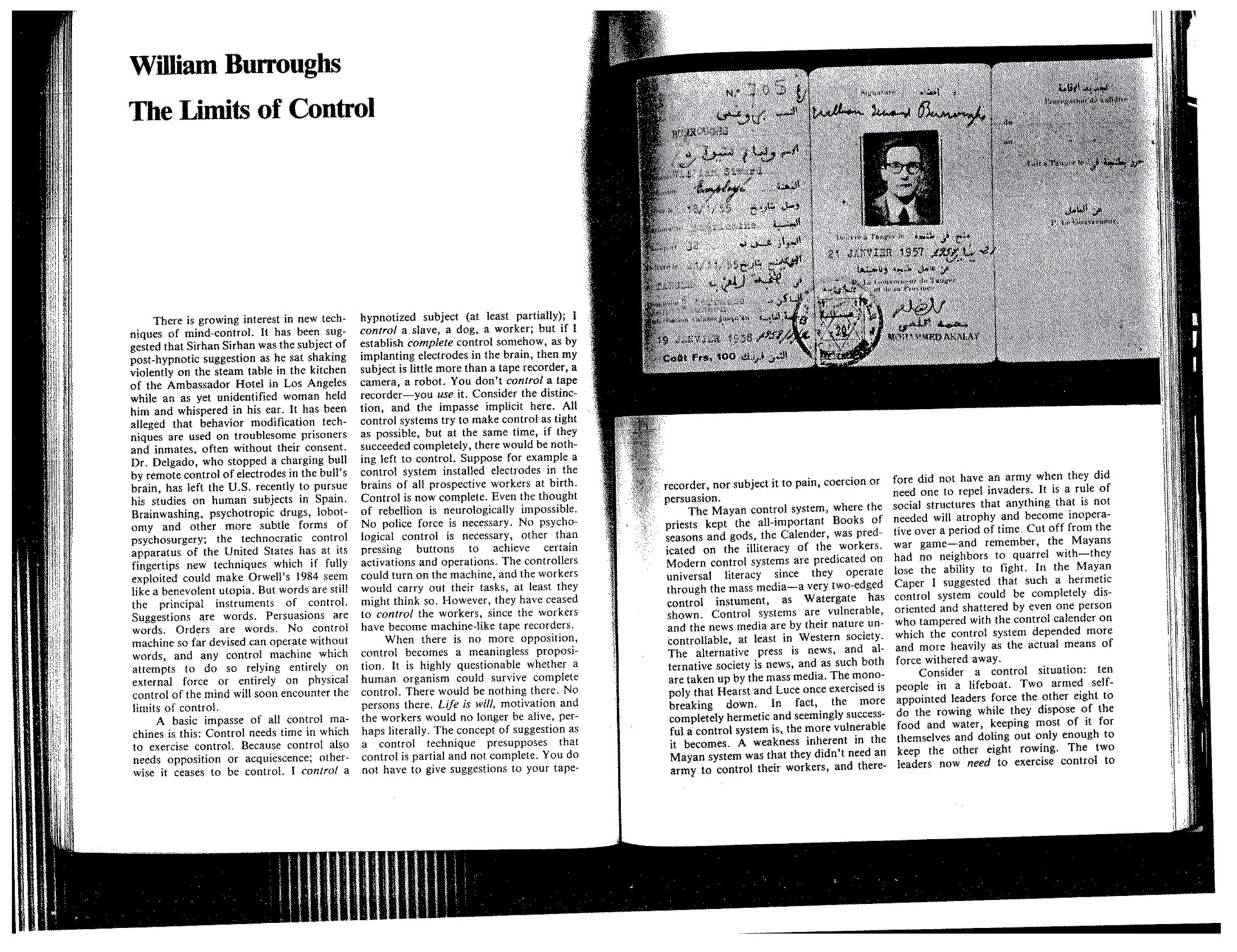An iconographic and text archive related to communication, technology and art.
Consider a control situation: ten people in a lifeboat. two armed self-appointed leaders force the other eight to do the rowing while they dispose of the food and water, keeping most of it for themselves an doling out only enough to keep the other eight rowing. The two leaders now need to exercise control to maintain an advantageous position which they could not hold without it. Here the method of control is force – the possession of guns. Decontrol would be accomplished by overpowering the leaders and taking their guns. This effected, it would be advantageous to kill them at once. So once embarked on a policy of control, the leaders must continue the policy as a matter of self-preservation. Who, then, needs to control others but those who protect by such control a position of relative advantage? Why do they need to exercise control? Because they would soon lose this position and advantage and in many cases their lives as well, if they relinquished control. […]
Extending the lifeboat analogy to the Ship of State, few existing governments could withstand a sudden, all-out attack by all their underprivileged citizens, and such an attack might well occur if the intentions of certain existing governments were unequivocally apparent. Suppose the lifeboat leaders had built a barricade and could withstand a concerted attack and kill all eight of the rowers if necessary. They would then have to do the rowing themselves and neither would be safe from the other. Similarly, a modern government armed with heavy weapons and prepared for attack could wipe out ninety-five percent of its citizens. But who would do the work, and who would protect them from the soldiers and technicians needed to make and man the weapons? Successful control means achieving a balance and avoiding a showdown where all-out force would be necessary. This is achieved through various techniques of psychological control, also balanced. The techniques of both force and psychological control are constantly improved and refined, and yet worldwide dissent has never been so widespread or so dangerous to the present controllers.
☛ “The Limits of Control” by William S. Burroughs, originally published in Semiotext(e): Schizo-Culture, vol. III, no. 2, 1978, pp. 38-42. See scans of the original publication (PDF) or read the whole text online (alternative link).

Particularly interesting while thinking about the way governments are actually dealing (trying to deal) with citizen uprisings in the Middle East.
Below are references to other sources using the ship metaphor to think either about the state or communities of men living together:
-
Plato’s Republic (tr. by Benjamin Jowett), book VI:
Imagine then a fleet or a ship in which there is a captain who is taller and stronger than any of the crew, but he is a little deaf and has a similar infirmity in sight, and his knowledge of navigation is not much better. The sailors are quarrelling with one another about the steering –every one is of opinion that he has a right to steer, though he has never learned the art of navigation and cannot tell who taught him or when he learned, and will further assert that it cannot be taught, and they are ready to cut in pieces any one who says the contrary.
-
Hume’s A Treatise of Human Nature (1739), book III, sect. II, art. ii:
Two men, who pull the oars of a boat, do it by an agreement or convention, though they have never given promises to each other.
-
Pierre Livet’s La Communauté virtuelle: action et communication (éd. de l’éclat, 1992, p. 234):
Reprenons l’exemple de Hume, celui des rameurs. Qu’ont-ils comme repères? Le résultat collectif de leurs mouvements individuels. Au début, ils ne rament pas à la même cadence, et donc ce résultat collectif ne fournit pas de discontinuités repérables. Dès qu’un des rameurs entend un telle discontinuité (ils ont par hasard donné un coup de rame en même temps), il se cale dessus en supposant que c’est le premier coup d’une cadence hypothétique. Il se peut qu’il soit encore décalé. Mais il dispose désormais d’un repère initial et peut donc interpréter son décalage comme un retard ou une avance, et donc corriger son mouvement. Et si aucune coïncidence aléatoire ne se produit, l’un ou l’autre peut marquer plus fortement un coup de rame pour donner un repère à l’autre. Si chacun suit ce processus, ils parviendront à se synchroniser.
-
Peter Sloterdijk Im selben Boot. Versuch über die Hyperpolitik (Suhrkamp, 1995). Translated in French in 1997: Dans le même bateau: Essai sur l’hyperpolitique (éd. Rivage)
-
D. C. Allen: “Donne and the Ship Metaphor” (Modern Language Notes, vol. 76, no. 4, April 1961, pp. 308-312):
The image of a ship caught in a storm and struggling to make harbor was to the fathers of poetry a superb way of expressing the life course of a hero or the political fate of a state. The metaphor is found with the first meaning in Aeschylus and with the second in Sophocles, who speaks of “the shipwreck of state” and the “well- steered ship of state.” The second figure of the ship of state was established in Italy by Cicero and is well-known to us through Horace’s “0 navis referent in mare te novi / fluctus.”
- By Philippe Theophanidis
- on
- ― Published in Communication, Technology
- Tagged: Burroughs, community, control, critic, government, metaphor, Politic, power, representation, resistance, ship, state
